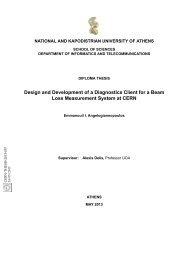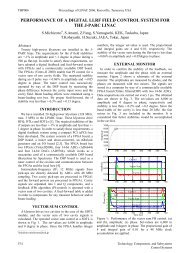Charged particle multiplicity in Pb-Pb collisions from NA50 experiment
Charged particle multiplicity in Pb-Pb collisions from NA50 experiment
Charged particle multiplicity in Pb-Pb collisions from NA50 experiment
Create successful ePaper yourself
Turn your PDF publications into a flip-book with our unique Google optimized e-Paper software.
<strong>Charged</strong> <strong>particle</strong> <strong>multiplicity</strong> <strong>in</strong><br />
<strong>Pb</strong>-<strong>Pb</strong> <strong>Pb</strong> <strong>Pb</strong> <strong>collisions</strong> <strong>from</strong> <strong>NA50</strong><br />
<strong>experiment</strong><br />
F. Pr<strong>in</strong>o for the <strong>NA50</strong> collaboration<br />
International Workshop on<br />
Particle Multiplicity <strong>in</strong> Relativistic Heavy Ion Collisions<br />
Bari, 17-19 June 2004
Particle production <strong>in</strong> nuclear <strong>collisions</strong><br />
Multiplicity = number of <strong>particle</strong>s produced <strong>in</strong> the collision<br />
80-90% of the produced charged <strong>particle</strong>s are pions<br />
Related to the centrality of the collision<br />
Related to the entropy of the system created <strong>in</strong> the collision<br />
Multicollision models:<br />
Nucleus-nucleus collis.= superposition of nucleon-nucleon collis.<br />
Hard processes<br />
Large momentum transfer<br />
Small distance<br />
� Interactions at partonic level<br />
� Scale like the number of<br />
elementary <strong>collisions</strong> (N coll )<br />
Soft processes<br />
Small momentum transfer<br />
Large distance<br />
� Interactions at the baryon level<br />
� Scale like the number of<br />
participant nucleons (N part )
Particle momenta distributions<br />
Particle momenta decomposed<br />
Transverse momentum (p ) T<br />
Longitud<strong>in</strong>al momentum (p ) L<br />
Rapidity variable<br />
1 ⎛ E<br />
y = ⋅ln⎜<br />
2 ⎝ E<br />
Pseudorapidity variable<br />
η≈y for large momenta<br />
dN/dy (dN/dη) distributions carry <strong>in</strong>formation about energy density,<br />
longitud<strong>in</strong>al expansion and "stopp<strong>in</strong>g power"<br />
+<br />
−<br />
p<br />
p<br />
⎡ ⎛ϑ<br />
⎞⎤<br />
1 ⎛ p + p<br />
η<br />
= −ln<br />
⎢<br />
tan⎜<br />
⎟⎥<br />
= ⋅ln<br />
⎜<br />
⎣ ⎝ 2 ⎠⎦<br />
2 ⎝ p − p<br />
L<br />
L<br />
⎞<br />
⎟<br />
⎠<br />
L<br />
L<br />
⎞<br />
⎟<br />
⎠
<strong>NA50</strong>: <strong>experiment</strong>al setup<br />
Study of muon pair production <strong>in</strong> <strong>Pb</strong>-<strong>Pb</strong> <strong>Pb</strong> <strong>Pb</strong> <strong>collisions</strong><br />
<strong>Pb</strong> beam<br />
1998: 158 GeV/nucleon<br />
1999: 40 GeV/nucleon<br />
Beam detectors<br />
Active target<br />
Up to 7 <strong>Pb</strong> subtargets +<br />
Cherenkov counters<br />
Centrality detectors<br />
Trigger<br />
EM Calorimeter (1.1
The Multiplicity Detector (MD)<br />
2 Planes (MD1, MD2)<br />
each plane made of 2 layers (up/down)<br />
36 azimuthal sectors (∆φ=10 o )<br />
192 radial strips (∆η=0.02)<br />
6912 strips <strong>in</strong> each plane<br />
Only 128 <strong>in</strong>nermost strips used <strong>in</strong> this analysis<br />
Silicon microstrip detector measur<strong>in</strong>g<br />
the number and the angular distribution<br />
of charged <strong>particle</strong>s produced <strong>in</strong> the collision
dN/dη distributions vs. centrality (I)<br />
Data <strong>from</strong> special low-<strong>in</strong>tensity runs<br />
<strong>Pb</strong> beam<br />
energy<br />
(GeV/nucleon<br />
)<br />
158<br />
158<br />
40<br />
Analysis method<br />
Data selection:<br />
Target<br />
<strong>Pb</strong><br />
<strong>Pb</strong><br />
<strong>Pb</strong><br />
� Interaction trigger<br />
� Pile-up rejection<br />
� Upstream <strong>in</strong>teraction rejection<br />
� Diagonal cut on the E T -E ZDC correlation<br />
� MD based target identification<br />
Distance target-MD1<br />
(cm)<br />
11.65<br />
9.15<br />
12.55<br />
� Statistical method based on match<strong>in</strong>g pairs<br />
of hits on MD1 and MD2<br />
Target<br />
thickness<br />
3 mm<br />
1 mm<br />
3 mm<br />
# of events<br />
analyzed<br />
48000<br />
18000<br />
35000
dN/dη distributions vs. centrality (II)<br />
Centrality <strong>in</strong>terval def<strong>in</strong>ition at 158 GeV/c:<br />
� 2 <strong>in</strong>dependent centrality variables (E T and E ZDC )<br />
� Intervals expressed <strong>in</strong> terms of fraction of total <strong>in</strong>elastic cross section<br />
N<strong>in</strong>t<br />
= N <strong>Pb</strong> ⋅ P<strong>in</strong>t<br />
−L<br />
N <strong>Pb</strong> e T / λ<br />
= ⋅ 1−<br />
INT with λINT<br />
=<br />
ATARG<br />
N<br />
= 3.<br />
98<br />
( ) + 0.<br />
21<br />
cm<br />
ρ<br />
<strong>Pb</strong><br />
A<br />
σ<br />
<strong>in</strong>el<br />
−0.<br />
27
dN/dη distributions vs. centrality (III)<br />
Calculation of raw dN ch /dη<br />
� Cluster (group of contiguous strips fir<strong>in</strong>g together) correction<br />
� Cluster size distribution not reproduced by a VENUS+GEANT simulation<br />
� Dedicated MC, aimed at reproduc<strong>in</strong>g cluster size distribution observed <strong>in</strong> data<br />
� Performed separately <strong>in</strong> each η b<strong>in</strong> (∆η=0.15) and <strong>in</strong> each centrality class
dN/dη distributions vs. centrality (III)<br />
Calculation of primary dN ch /dη .<br />
� Subtraction of the delta electron contribution (<strong>from</strong> GEANT).<br />
� Max. 5% of the occupancy <strong>in</strong> the most peripheral b<strong>in</strong>.<br />
� Correction with secondary/primary ratio <strong>from</strong> VENUS+GEANT simulation.<br />
� VENUS+GEANT data reconstructed<br />
with same method as <strong>experiment</strong>al data.<br />
� 1.2 –1.8 correction factor.<br />
�Do not depend on centrality.<br />
�Depend on target thickness, target<br />
position, particular MD plane.<br />
� Unstable <strong>particle</strong>s (K 0, Λ and hyperons)<br />
decays are already considered <strong>in</strong> VENUS,<br />
and therefore their decay products are<br />
def<strong>in</strong>ed as primary <strong>particle</strong>s.<br />
Systematic error estimation<br />
�8% systematic error on primary charged <strong>multiplicity</strong>
dN/dη distributions vs. centrality (III)<br />
Agreement between MD1 and MD2<br />
Average between detector planes<br />
Wide η coverage<br />
Excellent agreement between primary<br />
dN ch /dη with 2 different target<br />
thicknesses and positions<br />
Average between different thicknesses<br />
Wider η coverage
dN ch /dη distributions at 158 GeV<br />
E T centrality selection E ZDC centrality selection<br />
Distributions fitted with Gaussians to extract{<br />
Midrapidity value<br />
Gaussian width<br />
dN /dη at the peak
Midrapidity value at 158 GeV /c<br />
E T centrality selection E ZDC centrality selection<br />
Midrapidity visible <strong>in</strong> the dN/dη distributions:<br />
� No reflection around midrapididty needed<br />
� η peak extracted <strong>from</strong> fit compatible with VENUS predicion (η peak =3.1)
Gaussian width at 158 GeV /c<br />
E T centrality selection E ZDC centrality selection<br />
Gaussian width decreses with centrality:<br />
� stopp<strong>in</strong>g power effect<br />
� decreas<strong>in</strong>g contribution of protons <strong>from</strong> target and projectile fragmentation
dN ch /dη max at 158 GeV /c<br />
E T centrality selection E ZDC centrality selection<br />
dN/dη at the peak scales l<strong>in</strong>early with E T and E ZDC<br />
� no saturation or enhancement observed
dN ch /dη distributions at 40 GeV /c (I)<br />
ZDC worse performance<br />
at such a low energy<br />
•ZDC based quality cuts not performed<br />
� larger E T tail beyond the knee<br />
� E T resolution not well def<strong>in</strong>ed<br />
Only ET based centrality selection<br />
Larger (10%) systematic error
dN ch /dη distributions at 40 GeV /c (II)<br />
Peak position<br />
(VENUS prediction):<br />
η max ≈2.47<br />
Gaussian width smaller<br />
than at 158 GeV,<br />
decreas<strong>in</strong>g with <strong>in</strong>creas<strong>in</strong>g<br />
centrality<br />
Number of charged<br />
<strong>particle</strong>s <strong>in</strong> the<br />
more central b<strong>in</strong><br />
≈ 2 times smaller<br />
than at 158 GeV
Gaussian width vs. energy<br />
E877<br />
central<br />
Au-Au<br />
<strong>NA50</strong> most central <strong>Pb</strong>-<strong>Pb</strong><br />
ση<br />
= 0. 58 + 0.<br />
32⋅<br />
ln<br />
• Available phase space <strong>in</strong> rapidity <strong>in</strong>creases with √s<br />
• Fit with the simple scal<strong>in</strong>g law: σ η = a + b · ln √s<br />
• Same √s dependence for all data<br />
s
Evaluation of N part and N coll (I)<br />
Glauber model calculations<br />
Physical <strong>in</strong>puts:<br />
� Woods-Saxon density for <strong>Pb</strong> nucleus (2pF)<br />
� σ <strong>in</strong> = 30 mb<br />
Numerical calculation of:<br />
ρ<br />
ρ =<br />
1+<br />
e<br />
� Interaction probability, N part , N coll ... vs. impact parameter b<br />
0<br />
( r−r0<br />
) / C<br />
r0 = 6.624 fm<br />
ρ 0 = 0.16 fm -3<br />
C= 0.549 fm
Evaluation of N part and N coll (II)<br />
E T and E ZDC parametrization<br />
� E T ∝ number of participants<br />
� E ZDC ∝ number of projectile spectators<br />
part<br />
2<br />
⋅ N part<br />
2<br />
2<br />
q, w, α and δ form fit to MB spectra σ EZDC<br />
= ( β EZDC<br />
+ γ EZDC<br />
) + δ<br />
E<br />
ZDC<br />
=<br />
σ<br />
E<br />
E = q ⋅ N<br />
= w⋅<br />
q<br />
⎛ N<br />
⎜ A<strong>Pb</strong><br />
−<br />
⎝ 2<br />
T<br />
2<br />
ET<br />
beam<br />
part<br />
⎞<br />
⎟ + α N<br />
⎠<br />
2<br />
part
Evaluation of N part and N coll (III)<br />
Calculation of and <strong>in</strong> each centrality class<br />
From distributions of N part and N coll <strong>in</strong> the E T and E ZDC <strong>in</strong>tervals<br />
Smear<strong>in</strong>g effects due to calorimeter resolution <strong>in</strong>cluded
<strong>Charged</strong> <strong>particle</strong> scal<strong>in</strong>g<br />
at 158 GeV<br />
Fit with the power law:<br />
α=1.00±0.01±0.04<br />
� α = 1.05-1.08 us<strong>in</strong>g a VENUS calculation of N part<br />
� α = 1.02 with N part = 2·208 ·(1-E ZDC/E BEAM)<br />
Fit with the power law:<br />
β=0.75±0.02<br />
dN<br />
B compatible with zero d<br />
Fit with the law:<br />
Conclusions:<br />
dN<br />
dη<br />
dN<br />
dη<br />
η<br />
max<br />
max<br />
max<br />
α<br />
part<br />
N part describes the centrality dependence of <strong>particle</strong> production<br />
Hard processes play a negligible role at this energy<br />
∝<br />
∝<br />
N<br />
N<br />
β<br />
coll<br />
∝ A⋅<br />
N<br />
part<br />
+ B ⋅ N<br />
coll
<strong>Charged</strong> <strong>particle</strong> scal<strong>in</strong>g at 40 GeV<br />
Fit with the power law:<br />
α=1.02±0.02±0.06<br />
Conclusions:<br />
As expected, no important hard process<br />
contribution at this energy<br />
Same N part dependence at 158 and 40 GeV<br />
Soft processes account well for <strong>particle</strong><br />
production at SPS energies
Yield per participant pair vs. centrality<br />
Yield per participant pair:<br />
dNch<br />
dη<br />
0.<br />
5 N<br />
part<br />
max<br />
� Only statistical error on dN/dη +<br />
error on N part shown <strong>in</strong> plot<br />
� Flat behaviour reflects the l<strong>in</strong>ear<br />
dependence of dN/dη max on N part<br />
Beam energy<br />
(A·GeV/c)<br />
40<br />
158<br />
√s<br />
(GeV)<br />
8.77<br />
17.3<br />
dNch<br />
dη<br />
0.<br />
5 N<br />
part<br />
max<br />
1.18±0.03±0.15<br />
2.49±0.03±0.20
Comparison with other <strong>experiment</strong>s<br />
Conversion <strong>from</strong> dN/dη| lab to dN/dy and subsequently to dN/dη| cm done assum<strong>in</strong>g:<br />
At 158 GeV/c (√s=17.3 GeV): pions, protons and kaons relative yields <strong>from</strong> NA49<br />
At 40 GeV/c (√s=8.77 GeV): pions, protons and kaons relative yields <strong>from</strong> VENUS 4.12<br />
√s dNch<br />
dNch<br />
(GeV)<br />
dη<br />
max dη<br />
( LAB)<br />
max ( CMS)<br />
0.<br />
5 N<br />
0.<br />
5 N<br />
8.77<br />
17.3<br />
dNch<br />
=<br />
dp<br />
dη<br />
T<br />
1−<br />
m<br />
2<br />
T<br />
most central b<strong>in</strong><br />
part<br />
m<br />
2<br />
cosh<br />
1.18±0.03±0.15<br />
2.49±0.03±0.20<br />
2<br />
y<br />
dNch<br />
dp<br />
dy<br />
T<br />
part<br />
0.97±0.03±0.14<br />
2.14±0.03±0.17
40 GeV/c result:<br />
<strong>in</strong> agreement with<br />
fit to pp <strong>in</strong>elastic<br />
Yield per participant pair vs. √s<br />
158 GeV/c result:<br />
50% higher than fit to pp <strong>in</strong>elastic<br />
20% higher than fit to pp NSD<br />
1
Integrated yield per participant pair<br />
Heavy ion data does not follow the e + e - trend over the whole energy range:<br />
� below pp and e + e - data at AGS energy<br />
� cross through pp data at SPS energy<br />
� jo<strong>in</strong>s e + e - data above top SPS energy<br />
1
Conclusions<br />
Particle pseudorapidity distribution vs. centrality measured by <strong>NA50</strong> <strong>experiment</strong>.<br />
At 158 GeV/c with 2 <strong>in</strong>dependent centrality estimators (E T, E ZDC).<br />
At 40 GeV/c with 1 centrality estimator (E T).<br />
Use of 4 detector planes + 2 different target positions.<br />
Cross check of analysis procedure.<br />
Wide η coverage (� no reflection around midrapidity needed).<br />
Gaussian width:<br />
Decreases with centrality (stopp<strong>in</strong>g power effect).<br />
Increases logarythmically with √s (phase space effect).<br />
Glauber calculation of N part and N coll :<br />
L<strong>in</strong>ear dependence of dN/dη| max on N part.<br />
No important role of hard <strong>in</strong>teractions (N coll) at both energies.<br />
Yield per participant pair.<br />
� At 40 GeV/c (√s=8.77 GeV) compatible with fit to nucleon-nucleon <strong>in</strong>teractions.<br />
� At 158 GeV/c (√s=17.3 GeV) not compatible with fit to nucleon-nucleon <strong>in</strong>teractions.<br />
Steep <strong>in</strong>crease of <strong>particle</strong> yield <strong>in</strong> central <strong>Pb</strong>-<strong>Pb</strong> <strong>collisions</strong> between 40 and 158 GeV/c not<br />
described by the simple energy scal<strong>in</strong>g observed <strong>in</strong> nucleon nucleon <strong>collisions</strong>.<br />
1















